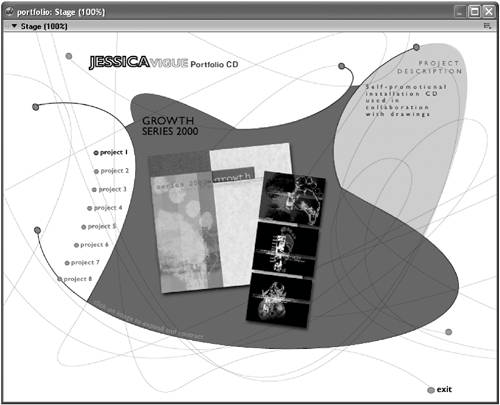Chapter 5. Introducing Lingo
| What You Will Learn In this lesson, you will:
Approximate Time This lesson should take you about 2 hours to complete. Lesson Files Media Files: None Starting Files: events.dir portfolio_start.dir Completed Files: portfolio.dir This is the fifth lesson in the Portfolio Presentation project. In this lesson you'll get to know more of the Lingo necessary for creating advanced projects as you add functionality to the portfolio project. The completed portfolio project  First, let's talk a little history. Lingo was first introduced in 1988 when VideoWorks Interactive Pro became Director 1.0. At that time John Henry Thompson and the lesser-known Erik Neumann replaced the original Tiny Basic engine with the Lingo scripting engine. Since its inception, Lingo has evolved from a somewhat cumbersome and verbose language into the robust object-oriented and dot-syntax-enabled language it is today. To be able to create more advanced applications and interactivity, you'll need a good solid foundation in Lingo. Knowing how Director passes events to various objects and how to handle those events is the first step in your understanding. Along with that, you'll explore the new Director Object Model (DOM), which is new in Director MX 2004. You also learn how to generalize behaviors using properties and how to use the getPropertyDescriptionList handler in order to produce custom dialog boxes for your behaviors. |
EAN: 2147483647
Pages: 166
- Overview of MPLS Forwarding
- Frame-Mode MPLS Configuration and Verification
- Command Reference
- L2TPv3 Overview
- Case Study 2: Implementing Multi-VRF CE, VRF Selection Using Source IP Address, VRF Selection Using Policy-Based Routing, NAT and HSRP Support in MPLS VPN, and Multicast VPN Support over Multi-VRF CE